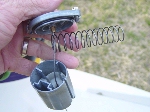One often used method to control throttle creep is by adding more friction to the factory quadrant. This is done by tightening the pivot screw/nut located near the bottom of the throttle lever. This will provide extra friction to maintain the throttle setting against the tension of the carburettor slide return spring(s) inside the carburetor(s). If you have a two place aircraft, both the front and back throttle quadrants may be tightened up, each a bit less than tightening a single quadrant. Experimentation will provide the correct tightness.



